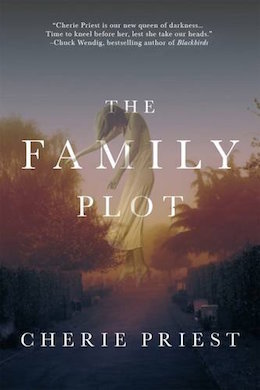The Family Plot is the latest novel from Cherie Priest. It’s a Southern Gothic horror set in Chattanooga, and it marks Priest’s return to Southern Gothic sensibilities. Her first three novels (Four and Twenty Blackbirds, Wings to the Kingdom, Not Flesh Nor Feathers) bore some of the hallmarks of the genre, before she spread out to explore zombie steampunk (the acclaimed Boneshaker and its sequels), Lovecraft meets Lizzie Borden (Maplecroft, Chapelwood), and Young Adult (I Am Princess X). Priest has never entirely left horror behind, since most of her work stirs a frisson of uncanny dread, or plays with horror tropes. (Like, for example, zombies.) But The Family Plot wholly embraces the inexplicable and inimical uncanny.
Horror’s never really been my cup of tea, but this is a really good gothic haunted house story. Until the very end, but I’ll get to that.
Chuck Dutton owns a salvage company, specialising in furniture and fittings. When the aged Augusta Withrow offers him the rights to salvage her family home—soon to be torn down and the land sold—it seems like the deal is too good to be true. The house is a fancy old property, with a bunch of period fittings and a carriage house that’s been shut up for a century. Short on funds (this is a deal that will either make or break his business) Chuck sends a small team to start work: his daughter, Dahlia, who’s just finished her divorce; her cousin Bobby, an abrasive personality who likes to drink; Bobby’s son Gabe, a nice young man; and doctoral student Brad, for whom the job will be his introduction to the business and to significant manual labour.
The deal seems too good to be true because it is. The house has great stuff in it, stuff that may keep the Dutton family business financially solvent for years. It’s also haunted by various apparitions: a soldier, a child, a young woman in a yellow sundress. At first, none of the four admit to each other that they have seen any evidence of the supernatural. But slowly, things grow weirder and more unsettling. Brad finds a cemetery hidden in the trees, a morbid Hallowe’en mockup based on unclaimed headstones from a previous Withrow’s funerary business. There should be no graves to go with them, but Brad has seen a spectre of a soldier, and is driven by the increased malevolent and uncanny happenings to prove there is an actual corpse there.
There is. This is the first real proof that something went very wrong at the Withrow house earlier in its history, and that the murderous spirit inhabiting it is not just a figment of their collective imagination. A murderous spirit that’s taken a particular interest in Dahlia, who seems to be the focus of its most frightening and its most palpable aggression. All four of them want to leave. But they need to get the job done.
Unfortunately, things only get creepier and more dangerous.
Most of The Family Plot is told from Dahlia’s point of view. She’s a fascinating character, complex, prickly, with strong feelings about her family and about old houses. She’s not quite as over her recent divorce as she’d like to be, either, and that lasting… not exactly grief, but a combination of regret and resentment… is a palpable presence in the narrative, a subtle counterpoint to the unhealthy and obsessive resentment cherished by the Withrow house’s brooding and violent poltergeist. The other characters are drawn just as strongly, although the ghostly presences have at times more striking and well-developed personalities than the three living men who’re working with Dahlia. (The house itself is an incredible character. Place matters, here: matters deeply. One of the most notable things about The Family Plot, as a southern Gothic haunted house horror novel, is the sense of ever-increasing claustrophobia. It’s about interiors, both literal and metaphorical: the interior of the house, and the inside of a person’s mind and/or emotions. The inside of the home turned strange and threatening: the inside of the self exposed and forced into the light.)
Priest has a striking prose style—she’s immensely readable—and a chilling ability to write really unnerving scenes. One scene especially, where Dahlia is taking a shower in the Withrow house, and malevolent presence fills the bathroom along with the steam, is the kind of writing that leaves a physical sense of dread in its wake. It made me glad I was reading during daylight. The pace is tight the whole way through, with tension that rises peak on peak up to the climactic crisis.
I really enjoyed The Family Plot up until its final page. But on its final page… well.
[Editor’s note—in discussing the ending of the novel, this review does not go into specific details, but does comment on the way the novel ends in general terms which may constitute a spoiler for some readers.]
It’s a convention of screen horror—and I haven’t read much in the genre, but perhaps it is a convention of literary horror, too—to provide a sense of catharsis, relief, safety in a denouement and then, as its final act, take that away and leave the true fate of the main character(s), or the true outcome, both unresolved and—for the viewer—unresolvable. I’ve always felt, when it comes to narrative, that this final irresolution is a transparently manipulative device. It feels like cheating. And The Family Plot does exactly that.
That closing emotional trick means that in retrospect I don’t love the novel as much as, up to that point, I was expecting to. But it’s a really solid novel, and very entertaining: if haunted house novels are your thing, definitely check this one out.
The Family Plot is available now from Tor Books.
Read an excerpt from the novel here on Tor.com
Liz Bourke is a cranky person who reads books. She holds a Ph.D in Classics from Trinity College, Dublin. Find her at her blog. Or her Twitter.










